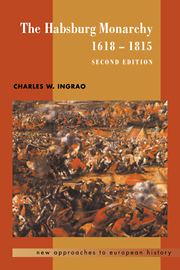Book contents
- Frontmatter
- Contents
- List of maps
- Genealogical tables
- Preface
- 1 The distinctiveness of Austrian history
- 2 The Thirty Years' War (1618–1648)
- 3 Facing east: Hungary and the Turks (1648–1699)
- 4 Facing west: the second Habsburg empire (1700–1740)
- 5 The Prussian challenge: war and government reform (1740–1763)
- 6 Discovering the people: the triumph of cameralism and enlightened absolutism (1765–1792)
- 7 The age of revolution (1789–1815)
- 8 Decline or disaggregation?
- Bibliography
- Index
- More titles in the NEW APPROACHES TO EUROPEAN HISTORY series
1 - The distinctiveness of Austrian history
- Frontmatter
- Contents
- List of maps
- Genealogical tables
- Preface
- 1 The distinctiveness of Austrian history
- 2 The Thirty Years' War (1618–1648)
- 3 Facing east: Hungary and the Turks (1648–1699)
- 4 Facing west: the second Habsburg empire (1700–1740)
- 5 The Prussian challenge: war and government reform (1740–1763)
- 6 Discovering the people: the triumph of cameralism and enlightened absolutism (1765–1792)
- 7 The age of revolution (1789–1815)
- 8 Decline or disaggregation?
- Bibliography
- Index
- More titles in the NEW APPROACHES TO EUROPEAN HISTORY series
Summary
On 9 June 1815 the representatives of the great European powers gathered in the Hofburg, the medieval city palace of the Habsburgs to sign the peace settlement that eliminated Napoleon's empire. The final act of the so-called Congress of Vienna was accompanied by no fanfare or celebration. Yet, as the last of the European princes and the other 100,000 visitors who had crowded into the city now departed for home, there was no mistaking the import of a treaty that would help define the European state system and preserve it from another great war for the next hundred years.
Although representatives of Great Britain, Prussia and Russia – and even defeated France – had played a major role in the peace negotiations, none had helped shape the course of the negotiations more than their Austrian hosts. And with good reason. Although it has always been fashionable to give the British Duke of Wellington the credit for defeating Napoleon at Waterloo, his fate had been sealed two years earlier when Austria entered the war. It was, in fact, the Austrian empire that had contributed the allied army's largest contingent and its commander-in-chief to the first conquest of France since the Franks. And it was the war aims of the emperor's foreign minister, Clemens von Metternich, that had served as the basis for the final peace settlement. Indeed, the so-called Metternich System that he directed from Vienna was destined to dominate the domestic and foreign policies of the continent until 1848.
- Type
- Chapter
- Information
- The Habsburg Monarchy, 1618–1815 , pp. 1 - 22Publisher: Cambridge University PressPrint publication year: 2000

